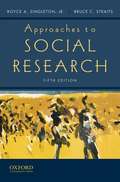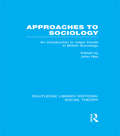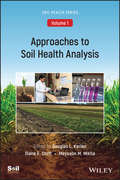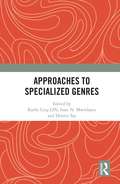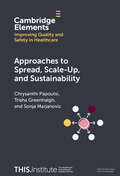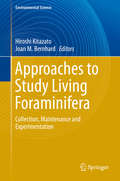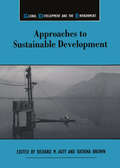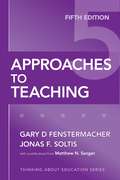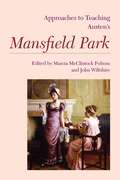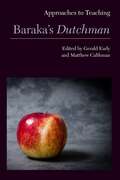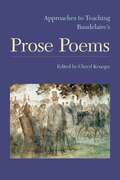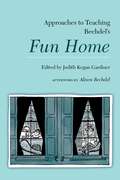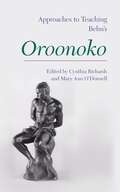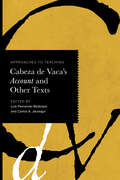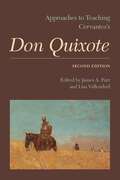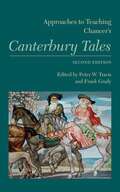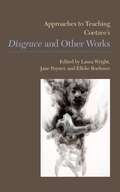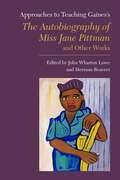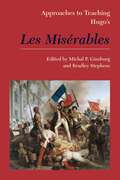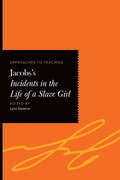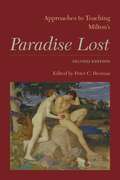- Table View
- List View
Approaches to Social Research
by Royce A. Singleton Bruce C. StraitsRevised and updated in its fifth edition, Approaches to Social Research is a rigorous yet clear and engaging introduction to research methods. Covering all of the fundamentals in a straightforward, student-friendly manner, it is ideal for undergraduate- and graduate-level courses across thesocial sciences and also serves as an indispensable guide for researchers. Striking a balance between specific techniques and the underlying logic of scientific inquiry, this book provides a lucid treatment of the four major approaches to research: experimentation, survey research, field research,and the use of available data. Richly developed examples of empirical research and an emphasis on the research process enable students to better understand the real-world application of research methods. The authors also offer a unique chapter (13) advocating a multiple-methods strategy.
Approaches to Sociology: An Introduction to Major Trends in British Sociology (Routledge Library Editions: Social Theory)
by John RexThese essays, commissioned by John Rex, reflect the state of sociology in Britain today. Leading representatives of the diverse ‘schools’ provide lucid accounts of their own particular approaches to this complex discipline and in doing so demonstrate the techniques described. Topics covered include the empirical study of stratification, social evolution, survey techniques, mathematical sociology, systems theory, phenomenological approaches, Weberian sociology, structuralism, contemporary Marxism, and the development of theory after Talcott Parsons.
Approaches to Soil Health Analysis (ASA, CSSA, and SSSA Books #190)
by Douglas L. Karlen Diane E. Stott Maysoon M. MikhaApproaches to Soil Health Analysis A concise survey of soil health analysis and its various techniques and applications The maintenance of healthy soil resources provides the foundation for an array of global efforts and initiatives that affect humanity. Whether they are working to combat food shortages, conserve our ecosystems, or mitigate the impact of climate change, researchers and agriculturalists the world over must be able to correctly examine and understand the complex nature of this essential, fragile resource. These new volumes have been designed to meet this need, addressing the many dimensions of soil health analysis in chapters that are concise, accessible and applicable to the tasks at hand. Soil Health, Volume One: Approaches to Soil Health Analysis provides a well-rounded overview of the various methods and strategies available to analysists, and covers topics including: The history of soil health and its studyChallenges and opportunities facing analysistsMeta-data and its assessmentApplications to forestry and urban land reclamationFuture soil health monitoring and evaluation approaches Offering a far-reaching survey of this increasingly interdisciplinary field, this volume will be of great interest to all those working in agriculture, private sector businesses, non-governmental organizations (NGOs), academic-, state-, and federal-research projects, as well as state and federal soil conservation, water quality and other environmental programs.
Approaches to Specialized Genres
by Dennis Tay Kathy Ling Lin Isaac N. MwinlaaruApproaches to Specialized Genres provides a timely update of the field of genre studies, with 14 cutting-edge contributions split into five sections using and integrating an exceptionally wide variety of methods and perspectives (such as ESP genre research, corpus linguistics, systemic functional linguistics, ethnographic and multimodal research) to analyse genres in written, spoken, visual and auditory modes across a multiplicity of pedagogic, professional and digital settings. It highlights and illustrates the growing trend of a multiperspective and inter-theoretic approach to genre studies and demonstrates how such methodological rigour can extend our knowledge of language, in general, and genres, in particular. It also examines a rich variety of underexplored genres such as the digital genre of synchronous videoconferencing, instructional slides, video ads, engineers’ training log book entries, the narrative story genres, fundraising letters and retraction notices. It demonstrates not only the prominent value of genre research, but wide applications of genre knowledge in various educational and professional domains. The book brings together experts spreading across the world, including countries in South-East Asia, Europe, America, West Africa and South America. Accordingly, it will appeal to readers of diversified socio-cultural backgrounds working in all the aforementioned inter-related fields of applied linguistics and communication studies.
Approaches to Spread, Scale-Up, and Sustainability (Elements of Improving Quality and Safety in Healthcare)
by Chrysanthi Papoutsi Trisha Greenhalgh Sonja MarjanovicFew interventions that succeed in improving healthcare locally end up becoming spread and sustained more widely. This indicates that we need to think differently about spreading improvements in practice. Drawing on a focused review of academic and grey literature, the authors outline how spread, scale-up, and sustainability have been defined and operationalised, highlighting areas of ambiguity and contention. Following an overview of relevant frameworks and models, they focus on three specific approaches and unpack their theoretical assumptions and practical implications: the Dynamic Sustainability Framework, the 3S (structure, strategy, supports) infrastructure approach for scale-up, and the NASSS (non-adoption, abandonment, and challenges to scale-up, spread, and sustainability) framework. Key points are illustrated through empirical case narratives and the Element concludes with actionable learning for those engaged in improvement activities and for researchers. This title is also available as Open Access on Cambridge Core.
Approaches to Study Living Foraminifera: Collection, Maintenance and Experimentation (Environmental Science and Engineering)
by Hiroshi Kitazato Joan M. BernhardForaminiferal cultures now serve as tools for researching biological, environmental, and geological topics. However, the biological backgrounds, in particular the natural histories of foraminifera, largely remain unclear. It is also true that the different techniques used in different subdisciplines are a setback to fully understanding the subject. Taken together, these factors prevent progress in experimental approaches to foraminiferal studies. This book aims to share and exchange knowledge between researchers from different subdisciplines, and the book should interest not only foraminiferal researchers but also scientists who are working with marine organisms to explore questions in relation to biology, geology, and oceanography.
Approaches to Sustainable Development
by Katrina Brown Richard M. AutyA definition of sustainable development is that of the Brundtland Commission - "...development which meets the needs of the current generation without jeopardizing the needs of future generations". This volume seeks to analyze the economic basis for this definition, and to look at the critiques of the economic approach - which have their basis in growing disquiet over the role of the productive normative science driving technological change and economic transformation. The discussion is followed by studies of the application of the criteria of sustainability to rural problems in South Asia, Kenya, Nepal, and Latin America and to urban/industrial problems in Jamaica, Chile and Vietnam.
Approaches to Teaching (5th edition)
by Jonas F. Soltis Gary D. Fenstermacher Matthew N. SangerThis popular text continues using the format of the three approaches--The Executive, The Facilitator, and The Liberationist. For the Fifth Edition, the authors add four new case studies: "Scripted Teaching," "Accountability and Merit," "What is the Value of Caring Relationships?" and "School Funding. " Using these and other realistic case studies, they explore the strengths and weaknesses of each approach so that teachers can critically assess their own philosophical positions on teaching. Teachers are urged to ask themselves such questions as: What is the main goal of teaching? What is the most important purpose of education? What do I expect my students to eventually become? Is the way I structure my teaching influenced by how I view my role and goals? This updated edition also adds a new section called "Topics and Resources" to encourage further inquiry into teaching
Approaches to Teaching Austen's Mansfield Park (Approaches to Teaching World Literature #135)
by John Wiltshire Marcia McClintock FolsomThere were no reviews of Mansfield Park when it first appeared in 1814. Austen's reputation grew in the Victorian period, but it was only in the twentieth century that formal and sustained criticism began of this work, which addresses the controversies of its time more than Austen's earlier novels did. Lionel Trilling praised Mansfield Park for exploring the difficult moral life of modernity; Edward Said brought postcolonial theory to the study of the novel; and twenty-first-century critics scrutinize these and other approaches to build on and go beyond them.This volume is the third in the MLA Approaches series to deal with Austen's work (Pride and Prejudice and Emma were the subject of the first and second volumes on Austen, respectively). It provides information about editions, film adaptations, and digital resources, and then nineteen essays discuss various aspects of Mansfield Park, including the slave trade, the theme of reading, elements of tragedy, gift theory, landscape design, moral improvement in the spirit of Samuel Johnson and of the Reformation, sibling relations, card playing, and interpretations of Fanny Price, the heroine, not as passive but as having some control.
Approaches to Teaching Austen's Persuasion (Approaches to Teaching World Literature #166)
by John Wiltshire Marcia M. FolsomJane Austen is a favorite with many students, whether they've read her novels or viewed popular film adaptations. But Persuasion, completed at the end of her life, can be challenging for students to approach. They are surprised to meet a heroine so subdued and self-sacrificing, and the novel's setting during the Napoleonic wars may be unfamiliar. This volume provides teachers with avenues to explore the depths and richness of the novel with both Austen fans and newcomers.Part 1, "Materials," suggests editions for classroom use, criticism, and multimedia resources. Part 2, "Approaches," presents strategies for teaching the literary, contextual, and philosophical dimensions of the novel. Essays address topics such as free indirect discourse and other narrative techniques; social class in Austen's England; the role of the navy during war and peacetime; key locations in the novel, including Lyme Regis and Bath; and health, illness, and the ethics of care.
Approaches to Teaching Baraka's Dutchman (Approaches to Teaching World Literature #153)
by Matthew CalihmanFirst performed in 1964, Amiri Baraka's play about a charged encounter between a black man and a white woman still has the power to shock. The play, steeped in the racial issues of its time, continues to speak to racial violence and inequality today.This volume offers strategies for guiding students through this short but challenging text. Part 1, "Materials," provides resources for biographical information, critical and literary backgrounds, and the play's early production history. The essays of part 2, "Approaches," address viewing and staging Dutchman theatrically in class. They help instructors ground the play artistically in the black arts movement, the beat generation, the theater of the absurd, pop music, and the blues. Background on civil rights, black power movements, the history of slavery, and Jim Crow laws helps contextualize the play politically and historically.
Approaches to Teaching Baudelaire's Prose Poems (Approaches to Teaching World Literature #142)
by Cheryl KruegerA prolific poet, art critic, essayist, and translator, Charles Baudelaire is best known for his volumes of verse (Les Fleurs du Mal [Flowers of Evil]) and prose poems (Le Spleen de Paris [Paris Spleen]). This volume explores his prose poems, which depict Paris during the Second Empire and offer compelling and fraught representations of urban expansion, social change, and modernity. Part 1, "Materials," surveys the valuable resources available for teaching Baudelaire, including editions and translations of his oeuvre, historical accounts of his life and writing, scholarly works, and online databases. In Part 2, "Approaches," experienced instructors present strategies for teaching critical debates on Baudelaire's prose poems, addressing topics such as translation theory, literary genre, alterity, poetics, narrative theory, and ethics as well as the shifting social, economic, and political terrain of the nineteenth century in France and beyond. The essays offer interdisciplinary connections and outline traditional and fresh approaches for teaching Baudelaire's prose poems in a wide range of classroom contexts.
Approaches to Teaching Bechdel's Fun Home (Approaches to Teaching World Literature #154)
by Judith Kegan GardinerAlison Bechdel's Fun Home: A Family Tragicomic has quickly joined the ranks of celebrated literary graphic novels. Set in part at a family-run funeral home, the book explores Alison's complicated relationship with her father, a closeted gay man. Amid the tensions of her home life, Alison discovers her own lesbian sexuality and her talent for drawing. The coming-of-age story and graphic format appeal to students. However, the book's nonlinear structure; intertextuality with modernist novels, Greek myths, and other works; and frank representations of sexuality and death present challenges in the classroom.This volume offers strategies for teaching Fun Home in a variety of courses, including literature, women's and gender studies, art, and education. Part 1, "Materials," outlines the text's literary, historical, and theoretical allusions. The essays of part 2, "Approaches," emphasize the work's genres, including autobiography and graphic narrative, as well as its psychological dimensions, including trauma, disability, and queer identity. The essays give options for reading Fun Home along with Bechdel's letters and drafts; her long-running comic strip, Dykes to Watch Out For; the Broadway musical adaptation of the book; and other stories of LGBTQ lives.
Approaches to Teaching Behn's Oroonoko (Approaches to Teaching World Literature #127)
by Cynthia Richards and Mary Ann O’DonnellOnce merely a footnote in Restoration and eighteenth-century studies and rarely taught, Oroonoko; or, The Royal Slave (1688), by Aphra Behn, is now essential reading for scholars and a classroom favorite. It appears in general surveys and in courses on early modern British writers, postcolonial literature, American literature, women's literature, drama, the slave narrative, and autobiography.Part 1 of this volume, "Materials," provides not only resources for the teacher of Oroonoko but also a brief chronology of Behn's life and work. In part 2, "Approaches," essays offer a diversity of perspectives appropriate to a text that challenges student assumptions and contains not one story but many: Oroonoko as a romance, as a travel account, as a heroic tragedy, as a window to seventeenth-century representations of race, as a reflection of Tory-Whig conflict in the time of Charles II.
Approaches to Teaching Cabeza de Vaca's Account and Other Texts (Approaches to Teaching World Literature #181)
by Luis Fernando Restrepo Carlos A. JáureguiIn 1527 Ã�lvar Núñez Cabeza de Vaca journeyed from Spain to Florida with the ill-fated Pánfilo de Narváez expeditionâ€"and ended up wandering by land for years with a small band of survivors before reaching Spanish outposts in modern-day Mexico. He later traveled to South America as an appointed provincial governor, only to be sent back to Spain in chains some years after his arrival. His written works describing his experiences provide insights into the lives of the indigenous peoples of the Americas and the attitudes of the Spanish conquistadores.This volume provides background about the texts and discusses new ways to teach them, challenging outdated readings that erase the violence of Spanish imperialism. Essays examine the role of the enslaved African Esteban in Cabeza de Vaca's account of the North American expedition, the indigenous and Spanish women who appear in the explorer's texts, Cabeza de Vaca's performance of multiple gender roles, and the reception of these works as examples of Chicano or Latin American literature. The volume also explores connections to archaeological findings and food studies.
Approaches to Teaching Cervantes's Don Quixote (Approaches to Teaching World Literature #134)
by James A. Parr and Lisa VollendorfThis second edition of Approaches to Teaching Cervantes'sDon Quixote highlights dramatic changes in pedagogy and scholarship in the last thirty years: today, critics and teachers acknowledge that subject position, cultural identity, and political motivations afford multiple perspectives on the novel, and they examine both literary and sociohistorical contextualization with fresh eyes.Part 1, "Materials," contains information about editions of Don Quixote, a history and review of the English translations, and a survey of critical studies and Internet resources. In part 2, "Approaches," essays cover such topics as the Moors of Spain in Cervantes's time; using film and fine art to teach his novel; and how to incorporate psychoanalytic theory, satire, science and technology, gender, role-playing, and other topics and techniques in a range of twenty-first-century classroom settings.
Approaches to Teaching Chaucer's Canterbury Tales (Approaches to Teaching World Literature #131)
by Frank Grady Peter W. TravisChaucer's Canterbury Tales was the subject of the first volume in the Approaches to Teaching series, published in 1980. But in the past thirty years, Chaucer scholarship has evolved dramatically, teaching styles have changed, and new technologies have created extraordinary opportunities for studying Chaucer. This second edition of Approaches to Teaching Chaucer's Canterbury Tales reflects the wide variety of contexts in which students encounter the poem and the diversity of perspectives and methods instructors bring to it. Perennial topics such as class, medieval marriage, genre, and tale order rub shoulders with considerations of violence, postcoloniality, masculinities, race, and food in the tales.The first section, "Materials," reviews available editions, scholarship, and audiovisual and electronic resources for studying The Canterbury Tales. In the second section, "Approaches," thirty-six essays discuss strategies for teaching Chaucer's language, for introducing theory in the classroom, for focusing on individual tales, and for using digital resources in the classroom. The multiplicity of approaches reflects the richness of Chaucer's work and the continuing excitement of each new generation's encounter with it.
Approaches to Teaching Coetzee's Disgrace and Other Works (Approaches to Teaching World Literature #130)
by Laura Wright, Jane Poyner, and Elleke BoehmerThe novels of the South African writer J. M. Coetzee won him global recognition and the Nobel Prize in Literature in 2003. His work offers substantial pedagogical richness and challenges. Coetzee treats such themes as race, aging, gender, animal rights, power, violence, colonial history and accountability, the silent or silenced other, sympathy, and forgiveness in an allusive and detached prose that avoids obvious answers or easy ethical reassurance.Part 1 of this volume, "Materials," identifies secondary materials, including multimedia and Internet resources, that will help instructors guide their students through the contextual and formal complexities of Coetzee's fiction. In part 2, "Approaches," essays discuss how to teach works that are sometimes suspicious of teachers and teaching. The essays aim to help instructors negotiate Coetzee's ironies and allegories in his treatment of human relationships in a changing South Africa and of the shifting connections between human beings and the biosphere.
Approaches to Teaching Dante's Divine Comedy (Approaches to Teaching World Literature #163)
by Christopher Kleinhenz and Kristina OlsonDante's Divine Comedy can compel and shock readers: it combines intense emotion and psychological insight with medieval theology and philosophy. This volume will help instructors lead their students through the many dimensions--historical, literary, religious, and ethical--that make the work so rewarding and enduringly relevant yet so difficult.Part 1, "Materials," gives instructors an overview of the important scholarship on the Divine Comedy. The essays of part 2, "Approaches," describe ways to teach the work in the light of its contemporary culture and ours. Various teaching situations (a first-year seminar, a creative writing class, high school, a prison) are considered, and the many available translations are discussed.
Approaches to Teaching Dostoevsky's Crime and Punishment (Approaches to Teaching World Literature #171)
by Michael R. Katz and Alexander BurryRecounting the murder of an elderly woman by a student expelled from university, Crime and Punishment is a psychological and political novel that portrays the strains on Russian society in the middle of the nineteenth century. Its protagonist, Raskolnikov, moves in a world of dire poverty, disillusionment, radicalism, and nihilism interwoven with religious faith and utopianism. In Dostoevsky's innovative style, which he called fantastic realism, the narrator frequently reports from within the protagonist's mind. The depiction of the desperate lives of tradespeople, students, alcoholics, prostitutes, and criminals gives readers insight into the urban society of St. Petersburg at the time.The first part of this book offers instructors guidance on editions and translations, a map of St. Petersburg showing locations mentioned in the novel, a list of characters and an explanation of the Russian naming system, and recommendations for further reading. In the second part, essays analyze key scenes, address many of Dostoevsky's themes, and consider the roles of ethics, gender, money, Orthodox Christianity, and social justice in the narrative. The volume concludes with essays on digital media, film adaptations, and questions of translation.
Approaches to Teaching Gaines's The Autobiography of Miss Jane Pittman and Other Works (Approaches to Teaching World Literature #161)
by John Wharton Lowe and Herman BeaversThe Autobiography of Miss Jane Pittman tells the story of a woman, a community, and the African American experience from the Civil War through Jim Crow to the civil rights movement. This narrative and Gaines's other novels and short stories explore the life of blacks in the South, their religious traditions and folkways, and their struggles under oppression. The southern communities described are diverse: blacks, creoles of color, poor whites, and wealthy landowners.Part 1 of this volume provides biographical information about Ernest Gaines and a discussion of critical and background studies of his narrative. The essays in part 2 will help teachers of African American literature, American literature, and southern literature convey to their students various aspects of Gaines's work and the adaptations of it in relation to southern literature, history, music, folk culture, and vernaculars of English.
Approaches to Teaching Hugo's Les Misérables (Approaches to Teaching World Literature #150)
by Bradley Stephens Michal P. GinsbugThe greatest work of one of France's greatest writers, Victor Hugo's Les Misérables has captivated readers for a century and a half with its memorable characters, its indictment of injustice, its concern for those suffering in misery, and its unapologetic embrace of revolutionary ideals. The novel's length, multiple narratives, and encyclopedic digressiveness make it a pleasure to read but a challenge to teach, and this volume is designed to address the needs of instructors in a variety of courses that include the novel in excerpts or as a whole.Part 1 of the volume, "Materials," provides guidance on editions in French and in English translation, biographies, criticism, and maps. Part 2, "Approaches," contains essays that discuss the novel's conceptions of misère, sexuality, and the politics of the time and that demonstrate techniques for teaching context including the book's literary market, its adaptations, its place in popular culture, and its relation to other novels of its time.
Approaches to Teaching Jacobs's Incidents in the Life of a Slave Girl (Approaches to Teaching World Literature #176)
by Lynn DominaOne of the most commonly taught slave narratives, Harriet Jacobs's Incidents in the Life of a Slave Girl is rightly celebrated for its progressive and distinctive appeals to dismantle the dehumanizing system of American slavery. Depicting the abuse Jacobs experienced, her years in hiding, and her escape to the North, the work evokes sympathy for Jacobs as a woman and a mother. Today, it continues to inform readers about gender and sexuality, power and justice, and Black identity in the United States.Part 1 of this volume, "Materials," discusses different editions of the work and suggests background readings. The essays in part 2, "Approaches," explore Jacobs's literary techniques and influences, drawing on autobiography theory, medical humanities, and theology, among other perspectives. Contributors also propose pairings with historical and recent literary works as well as teaching approaches involving visual arts, geography, archives, digital humanities, and service learning.
Approaches to Teaching Langland's Piers Plowman (Approaches to Teaching World Literature #151)
by Thomas A. GoodmannA series of dream visions, Piers Plowman is a moral reckoning of the whole of medieval England, in which every part of society--from church and king to every sort of "folk"--is considered in the light of the narrator's interpretation of Christian revelation. The Middle English poem, rich and beautiful, is a particular challenge to teach: it exists in three versions, lacks a continuous narrative, is written in a West Midlands dialect, weaves a complex allegory, and treats complicated social and political issues, such as labor, Lollardy, and popular uprising.Part 1 of this volume, "Materials," discusses the different versions, critical and classroom editions, and translations of the poem, as well as the many secondary sources. Part 2, "Approaches," helps students engage with the poem's versification, understand its protagonist and its treatment of poverty and equity, and discern connections to the work of other medieval poets, such as Dante and Chaucer.
Approaches to Teaching Milton's Paradise Lost: second edition (Approaches to Teaching World Literature #122)
by Peter C. Herman Elizabeth Sauer Anthony Welch Achsah Guibbory Jessica Wolfe Regina Schwartz Abraham Stoll Gregory M. Semenza Randall IngramThis second edition of Approaches to Teaching Milton's Paradise Lost addresses Milton in the light of the digital age, new critical approaches to his poem, and his continued presence in contemporary culture. It aims to help instructors enliven the teaching of Paradise Lost and address the challenges presented to students by the poem--the early modern syntax and vocabulary, the political and theological contexts, and the abounding classical references.The first part of the volume, "Materials," evaluates the many available editions of the poem, points to relevant reference works, recommends additional reading, and outlines useful audiovisual and online aids for teaching Milton's epic poem. The essays in the second part, "Approaches," are grouped by several themes: literary and historical contexts, characters, poetics, critical approaches, classrooms, and performance. The essays cover epic conventions and literary and biblical allusions, new approaches such as ecocriticism and masculinity studies, and reading Milton on the Web, among other topics.
